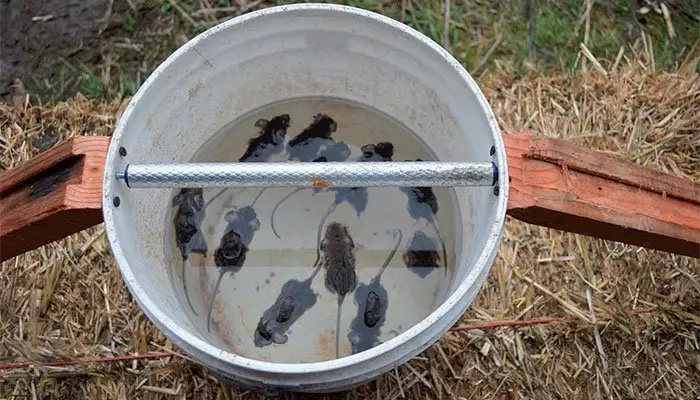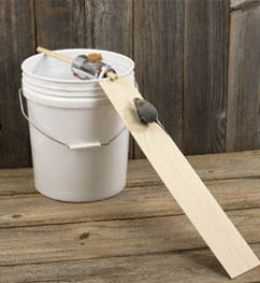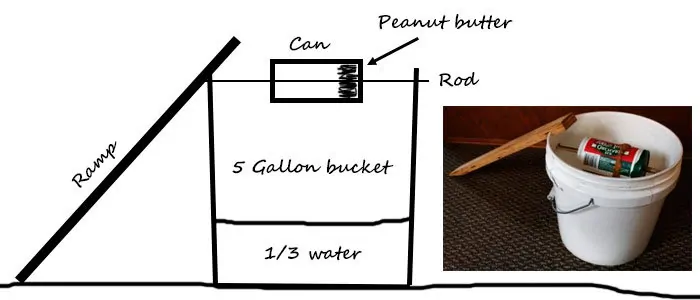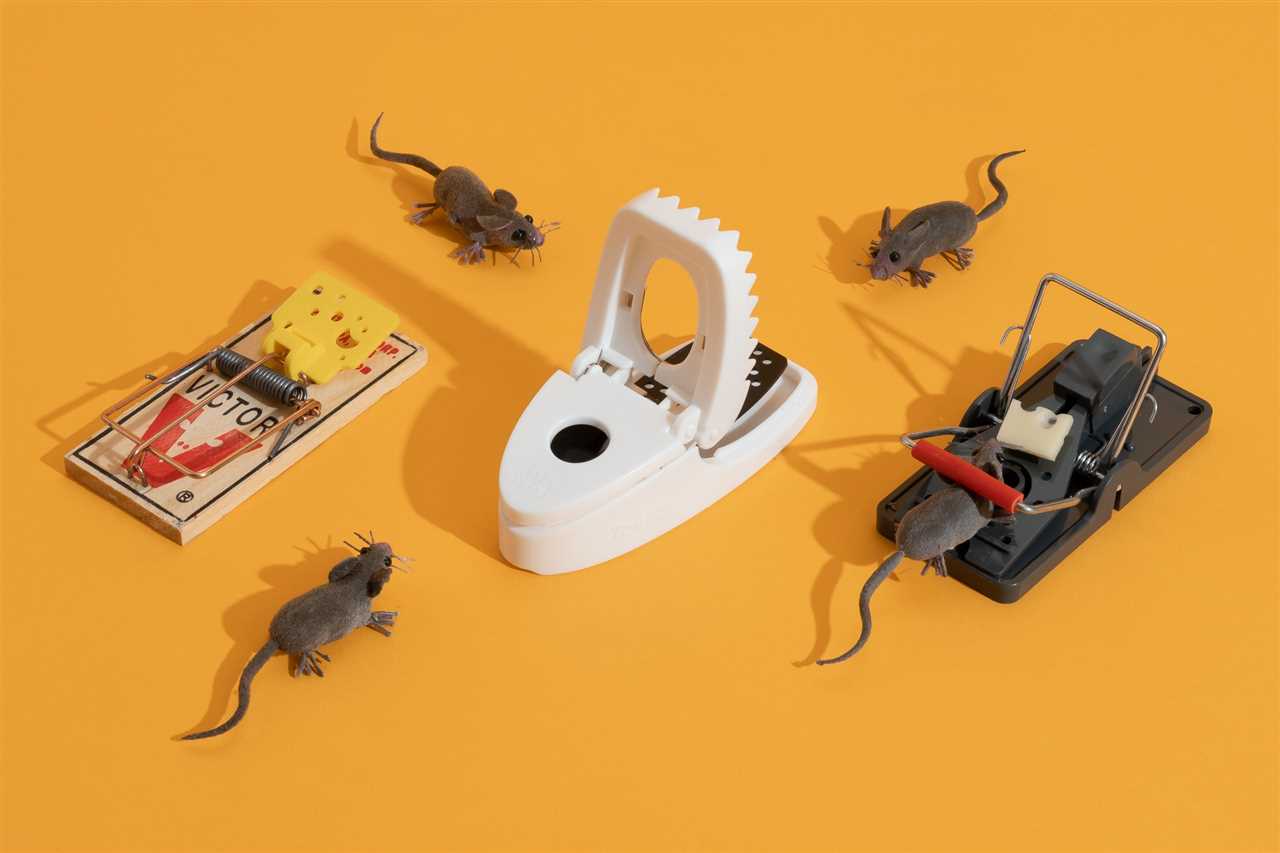Contents
How to Make a Bucket Rat Trap Step-by-Step Guide

Pests such as mice and rats can be a nuisance in any home or garden. They can cause damage to property, spread diseases, and contaminate food. One effective way to catch and kill these rodents is by using a bucket rat trap. This simple yet ingenious trap can be made easily with a few household items and some bait.
To make a bucket rat trap, you will need a bucket, a wire or string, a can or bottle, a wooden plank, and some bait. The first step is to place the bucket in an area where you have seen rat activity. Position the bucket in such a way that the rats can easily climb up to it.
Next, attach the wire or string to the handle of the bucket and tie it securely. This will prevent the rats from knocking over the bucket and escaping. Then, place the can or bottle on the plank and position it in such a way that it hangs over the edge of the bucket. This will act as a ramp for the rats to climb up.
Finally, add some bait to the can or bottle. Rats are attracted to strong-smelling foods such as cheese or peanut butter. Place a small amount of bait on the can or bottle to entice the rats to climb up and fall into the bucket. Once the rats enter the bucket, they will be unable to climb out and will eventually drown.
Remember to check the trap regularly and dispose of any trapped rats in a safe and hygienic manner. This bucket rat trap is an effective and humane way to catch and kill pests without the use of harmful chemicals or poisons. By following this step-by-step guide, you can rid your home or garden of rats and keep them from causing further damage.
Overview of the Bucket Rat Trap

A bucket rat trap is an effective method to catch and kill rats or other rodents that may be causing problems in your home or garden. This trap is designed to lure the pests into a bucket and prevent them from escaping, ultimately leading to their demise.
The concept of the bucket rat trap is simple yet ingenious. It involves setting up a bucket with a ramp or a plank leading up to the top. The rats are enticed to climb the ramp using bait such as food or a lure. Once they reach the top, they lose their balance and fall into the bucket, unable to climb out.
By using a bucket rat trap, you can safely and humanely eliminate the pest problem without resorting to harmful chemicals or poisons. This method is particularly effective for catching rats or mice that may be difficult to catch using other means.
When setting up a bucket rat trap, it is important to choose the right location. Look for areas where rats are known to frequent, such as dark corners, near food sources, or along walls. Make sure the trap is stable and secure, as rats can be cautious and may avoid the trap if they sense danger.
It is also crucial to use an enticing bait to attract the rats to the trap. Rats are known to be attracted to food scraps, grains, or even sweet treats like chocolate or peanut butter. Place the bait at the top of the ramp or on the edge of the bucket to lure the rats towards the trap.
Regularly check the trap to see if any rats have been caught. If you have successfully caught a rat, it is important to dispose of it properly. Wear gloves and use caution when handling the trap to avoid any potential diseases or infections.
In conclusion, a bucket rat trap is a simple yet effective method to catch and eliminate rats or other rodents. By using bait and a bucket, you can safely and efficiently control the pest problem in your home or garden.
What is a Bucket Rat Trap?
A bucket rat trap is a type of pest control device designed to catch and kill rodents, particularly rats. It consists of a bucket or container filled with water or another liquid, along with a mechanism to trap the rat once it enters the trap.
The basic concept of a bucket rat trap is to lure the rat into the trap using bait, such as food or a scent that attracts rodents. Once the rat is tempted by the bait and enters the trap, it falls into the liquid-filled bucket and is unable to escape. The rat eventually drowns or succumbs to exhaustion, resulting in its demise.
Bucket rat traps are often homemade and can be constructed using simple materials found around the house. They are an effective and affordable way to control rat populations, especially in outdoor areas where rats may be a common nuisance.
When setting up a bucket rat trap, it is important to choose an appropriate location where rats are likely to frequent. Placing the trap near areas where rats have been observed or where they access food sources is crucial for success.
It is also essential to select the right type of bait that will attract rats. Common bait options include peanut butter, cheese, or even small pieces of fruit. The smell and taste of the bait are key to enticing the rat into the trap.
Bucket rat traps can be an effective method for catching and eliminating rats, but they should always be used responsibly and in compliance with local laws and regulations regarding pest control. It is important to regularly check and empty the trap to prevent the buildup of dead rodents and to maintain the trap’s effectiveness.
Why Use a Bucket Rat Trap?

Using a bucket rat trap is an effective and humane way to trap and kill rodents such as rats and mice. These pests can cause damage to your property and spread diseases, so it’s important to take measures to control their population.
A bucket rat trap is a simple yet highly efficient device that can be easily made at home. It consists of a bucket, a ramp, and a mechanism to catch the rodent. The trap works by luring the rat with bait, causing it to fall into the bucket and be unable to escape.
There are several reasons why using a bucket rat trap is a great option for dealing with rodent problems:
- Cost-effective: Making a bucket rat trap requires minimal materials and can be done using items you may already have at home, such as a bucket and a piece of wood for the ramp.
- Easy to set up: Setting up a bucket rat trap is a straightforward process that doesn’t require any special skills or tools. Simply place the trap in an area frequented by rodents and add bait to attract them.
- Highly effective: Bucket rat traps have proven to be highly effective in catching and killing rats and mice. The design of the trap makes it difficult for the rodent to escape once it falls into the bucket.
- Humane: While bucket rat traps are designed to kill rodents, they provide a more humane method compared to using poison or snap traps. The rodent is quickly and painlessly dispatched, minimizing its suffering.
- Reusable: Unlike some other types of traps, bucket rat traps can be easily emptied and reset for future use. This makes them a cost-effective and environmentally friendly option for long-term rodent control.
Overall, using a bucket rat trap is a practical and efficient solution for dealing with rodent infestations. Whether you have a small mice problem or a larger rat issue, a bucket rat trap can help you effectively eliminate these pests from your home or property.
Materials Needed

To catch and kill mice or rats, you will need the following materials:
- A bucket or container: This will serve as the main trap.
- A rodent bait: Choose a bait that is attractive to mice or rats, such as cheese, peanut butter, or seeds.
- A ramp or plank: This will act as a bridge for the rodents to climb up to the bucket.
- A wire or string: This will be used to secure the bait to the bucket.
- Water: Fill the bucket partially with water to ensure the rodents drown.
Note: Make sure to place the bucket in an area where you have seen rodent activity or where you suspect their presence. Keep in mind that this trap is intended to catch and kill pests, so use caution and handle the trap responsibly.
Essential Materials

To effectively kill and trap rodents, you will need the following essential materials:
- Bucket: A sturdy bucket with a wide opening is necessary for this trap. Make sure the bucket is deep enough to prevent the rat from escaping once it falls in.
- Bait: Choose a bait that is attractive to rats, such as peanut butter, bacon, or cheese. Place the bait at the edge of the bucket to lure the rodent inside.
- Platform: A small platform or plank is required to serve as a bridge between the ground and the edge of the bucket. This will entice the rat to walk onto the platform and fall into the bucket.
- Water: Fill the bucket with enough water to ensure the rat drowns once it falls in. The water level should be at least a few inches deep.
- Sturdy Stick: A long and sturdy stick is needed to act as a lever. This will be used to release the bucket and trigger the trap once the rat steps onto the platform.
By gathering these essential materials, you will be well-equipped to set up an effective bucket rat trap and eliminate these pesky rodents from your space.
Bucket
A bucket is an essential component of a bucket rat trap. It is used to catch and kill mice or rats that are causing problems in your home or garden. The concept behind the bucket trap is simple but effective. The rodent is lured to the trap with bait, which is placed on a platform over the bucket. When the rodent steps onto the platform to reach the bait, the platform tips, and the rodent falls into the bucket, where it is unable to escape.
The bucket trap is a humane way to catch and kill rodents without the use of chemicals or poisons. It is also an effective method for dealing with pests that may be resistant to other types of traps. The trap can be easily constructed using materials that are commonly found around the house.
To build a bucket trap, you will need the following materials:
- A sturdy bucket
- A wooden or metal platform
- Bait (such as peanut butter or cheese)
Here is a step-by-step guide to building a bucket rat trap:
- Find a suitable location for the trap. This could be near areas where you have noticed rodent activity, such as along walls or near food sources.
- Place the bucket on the ground in the chosen location.
- Attach the platform to the bucket. This can be done by placing a wooden or metal plank across the top of the bucket, ensuring that it is securely attached.
- Apply bait to the platform. Peanut butter or cheese works well as bait, as it has a strong smell that will attract rodents.
- Ensure that the bait is securely attached to the platform and cannot be easily knocked off.
- Wait for the rodent to be lured to the trap by the smell of the bait.
- When the rodent steps onto the platform to reach the bait, the platform will tip, and the rodent will fall into the bucket.
- Check the trap regularly and dispose of any trapped rodents.
The bucket rat trap is an effective and humane way to deal with rodent pests. It is a simple DIY project that can be easily constructed using materials that are readily available. By following these steps, you can create a trap that will help to eliminate rodents from your home or garden.
Wooden Plank

A wooden plank is an essential component of a bucket rat trap. It serves as a platform for the rodents to walk on, leading them towards the bucket.
Here is how you can use a wooden plank effectively in your rat trap:
- Choose a sturdy wooden plank that is long enough to span across the top of the bucket.
- Position the plank in a way that creates a bridge between a solid surface and the top of the bucket.
- Make sure the plank is wide enough for the rodents to comfortably walk on.
- Secure the plank in place, ensuring it does not move or wobble.
- Place the plank at an angle, sloping towards the top of the bucket.
- Consider adding some texture to the plank’s surface to make it easier for the mice or rats to grip.
Remember, the purpose of the wooden plank is to entice the rodents to walk towards the bucket in search of the bait. Once they step onto the plank, their weight will cause it to tilt, leading them to fall into the bucket.
Make sure to position the bait strategically on the plank to lure the rodents towards it. Peanut butter, cheese, or any food with a strong odor can be used as effective bait.
Keep in mind that rodents are cautious creatures, so it may take some time for them to trust the wooden plank and the trap. Be patient and check the trap regularly to see if you have successfully caught any pests.
Additional Materials

Aside from the basic materials needed to construct a bucket rat trap, there are a few additional items that can help increase the effectiveness of the trap and ensure a successful capture and elimination of pests. These materials include:
- Bait: Choose a bait that is irresistible to rats, such as peanut butter, bacon, or dried fruit. The strong scent will attract the rodents to the trap.
- Bucket: Select a bucket that is deep enough to prevent the rat from escaping once it falls inside. A bucket with a diameter of at least 12 inches is recommended.
- Water: Fill the bucket with enough water to ensure that the rat cannot touch the bottom and climb out. This will effectively drown the pest.
- Sturdy Stick: Find a sturdy stick or rod that is long enough to span across the top of the bucket. This will serve as a bridge for the rat to access the bait.
- Wire or String: Attach one end of the wire or string to the stick and the other end to the bucket handle. This will create a mechanism that will release the stick once the rat steps on it, causing the rat to fall into the bucket.
By gathering these additional materials, you can enhance the functionality of the bucket rat trap and increase your chances of catching and killing the pesky rodents that have invaded your space.
Wire
Wire is an essential component of a bucket rat trap. It helps to create a mechanism that can effectively catch and kill rodents such as mice and rats. The wire is used to suspend a baited container over a bucket, allowing the pest to enter but preventing their escape.
Materials needed:
- Sturdy wire
- Wire cutters
- Pliers
Step-by-step guide:
- Measure and cut a length of wire that is long enough to span across the top of the bucket.
- Using pliers, bend both ends of the wire into loops to prevent the wire from slipping off the bucket.
- Position the wire across the top of the bucket, ensuring that it is securely attached to the sides.
- Attach the wire to the sides of the bucket using pliers to twist the loops tightly.
- Ensure that the wire is level and balanced so that the baited container can hang freely.
- Test the wire by gently tugging on it to make sure it is securely attached to the bucket.
- Once the wire is properly secured, you can proceed with setting up the rest of the trap.
Wire is an important element in the construction of a bucket rat trap as it helps to create a reliable and effective mechanism. It prevents the rodent from escaping once it enters the trap, ensuring a successful catch. With the right materials and careful construction, a wire can be easily incorporated into the trap to help control and eliminate pests.
Bait
In order to successfully catch rodents using a bucket rat trap, bait is an essential element. The right bait will attract pests like rats and mice, enticing them to enter the trap and ultimately meet their demise.
Choosing the Right Bait
When selecting bait for your bucket rat trap, it’s important to consider the preferences of rodents. They are attracted to certain smells and tastes, and using the right bait will increase your chances of success.
Here are some commonly used baits for bucket rat traps:
- Peanut butter: The strong scent of peanut butter is highly appealing to rats and mice. It is sticky and can be smeared on the trap’s trigger mechanism or placed on a small piece of bread or cracker.
- Cheese: Contrary to popular belief, cheese is not the most effective bait for rodents. While some rats and mice may be enticed by cheese, it is not as reliable as other options.
- Chocolate: The sweet smell of chocolate can attract rodents, making it a good bait option. You can use a small piece of chocolate or spread some melted chocolate on the trigger mechanism.
- Nutella: This hazelnut spread is another sweet option that can be used as bait. Rats and mice are drawn to its rich aroma, and it can be spread on the trap or placed on a piece of bread.
- Meat or fish: Fresh or spoiled meat and fish can be used as bait, as the strong smell is enticing to rodents. However, this option may attract other pests like flies, so it should be used with caution.
Bait Placement
Where you place the bait in the bucket rat trap is also important. It should be positioned in a way that forces the rodent to step on the trap’s trigger mechanism, causing it to fall into the bucket.
Here are some tips for bait placement:
- Place the bait on the trap’s trigger mechanism, ensuring that the rodent has to step on it to access the bait.
- Secure the bait in place using a small amount of tape or by attaching it to the trigger mechanism with a toothpick.
- Consider placing the bait in a small container or wrapping it in a mesh bag to prevent the rodent from easily grabbing it and escaping without triggering the trap.
Remember, the success of your bucket rat trap depends on the bait you choose and how you position it. Experiment with different options to find what works best for your particular rodent problem.
Water

Water is an essential element in the bucket rat trap. It plays a crucial role in catching and killing rats, pests, and rodents. The bucket trap uses water as a means to drown the rodents, effectively eliminating them from your surroundings.
The bucket trap takes advantage of a rat’s natural instinct to seek out water sources. Rats are attracted to the smell of water and will approach the trap in search of it. The trap’s design lures the rat onto a platform or plank that is balanced on top of the bucket.
When the rat steps onto the platform to access the bait, the weight causes the platform to tilt, sending the rat into the water-filled bucket. Once in the bucket, the rat is unable to escape and eventually drowns.
Water is an important component of the trap’s effectiveness. It ensures that the rat is caught and killed without the need for harmful chemicals or poisons. The use of water as a trapping method is considered humane as it mimics a natural drowning process for the rodent.
When setting up the bucket trap, it is important to fill the bucket with enough water to submerge the rat completely. This ensures a quick and humane kill. The water also prevents the rat from climbing out of the bucket or escaping the trap.
It is recommended to place the bucket trap in areas where rats are known to frequent, such as near food sources or in dark corners. Adding a bait, such as peanut butter or cheese, to the platform can further attract rats to the trap.
Overall, water is a vital component in the bucket rat trap as it serves as the mechanism for catching and eliminating pests. Its use provides a humane and effective method for dealing with rat infestations or rodent problems in your surroundings.
Video:How to Make a Bucket Rat Trap Step-by-Step Guide
5 Gallon bucket mouse trap how to ( easy )
5 Gallon Bucket Rat Trap || DIY Homemade Rat Trap
bottle rat/mouse trap
Hello, I am Beverly J. Sanders, the voice behind the diverse articles you come across on styves.co.za. My passion lies in exploring the nuances of home improvement and sharing tips that can help you transform your living space into a haven of comfort and style. From the latest trends in home decor to practical cleaning advice, I cover a broad spectrum of topics to cater to a wide variety of interests.
In my recent works, I have delved into the advantages of incorporating a horizontal Murphy bed into your home to save space without compromising on design and functionality. I also explored the benefits of having a free-standing electric fireplace that not only adds warmth to your home but also brings a sleek and modern design to any living space. My articles are a rich resource, offering insights into different products and home improvement strategies that can enhance the quality of your life.
I believe in the power of details; a belief that reflects in my comprehensive guides where I discuss even the overlooked aspects of home decor, such as the impact of baseboard trim in enhancing the overall look and feel of your home. I am constantly on the lookout for innovative solutions and products that can add value to your home and life.
Join me in my exploration as I continue to bring you the latest trends, tips, and insights in the home improvement world. Let’s create a home that is not just a place to live, but a reflection of style and personality.